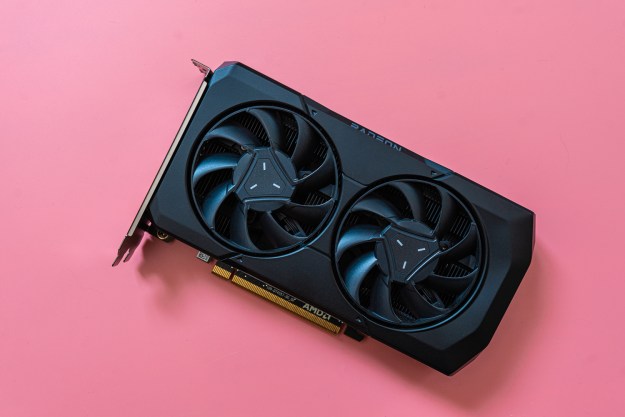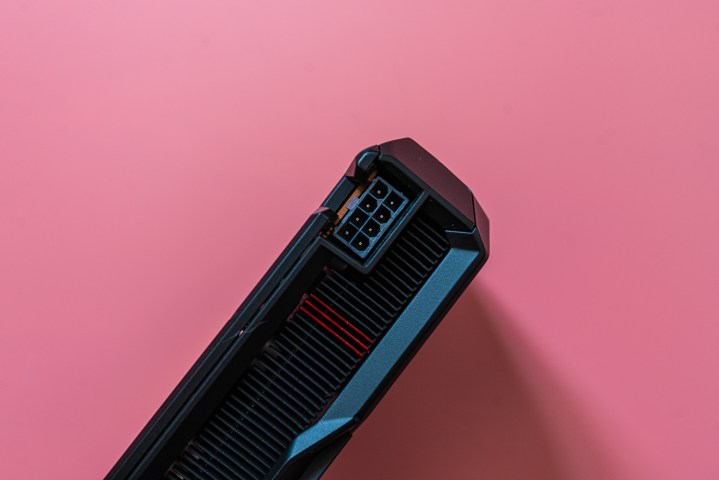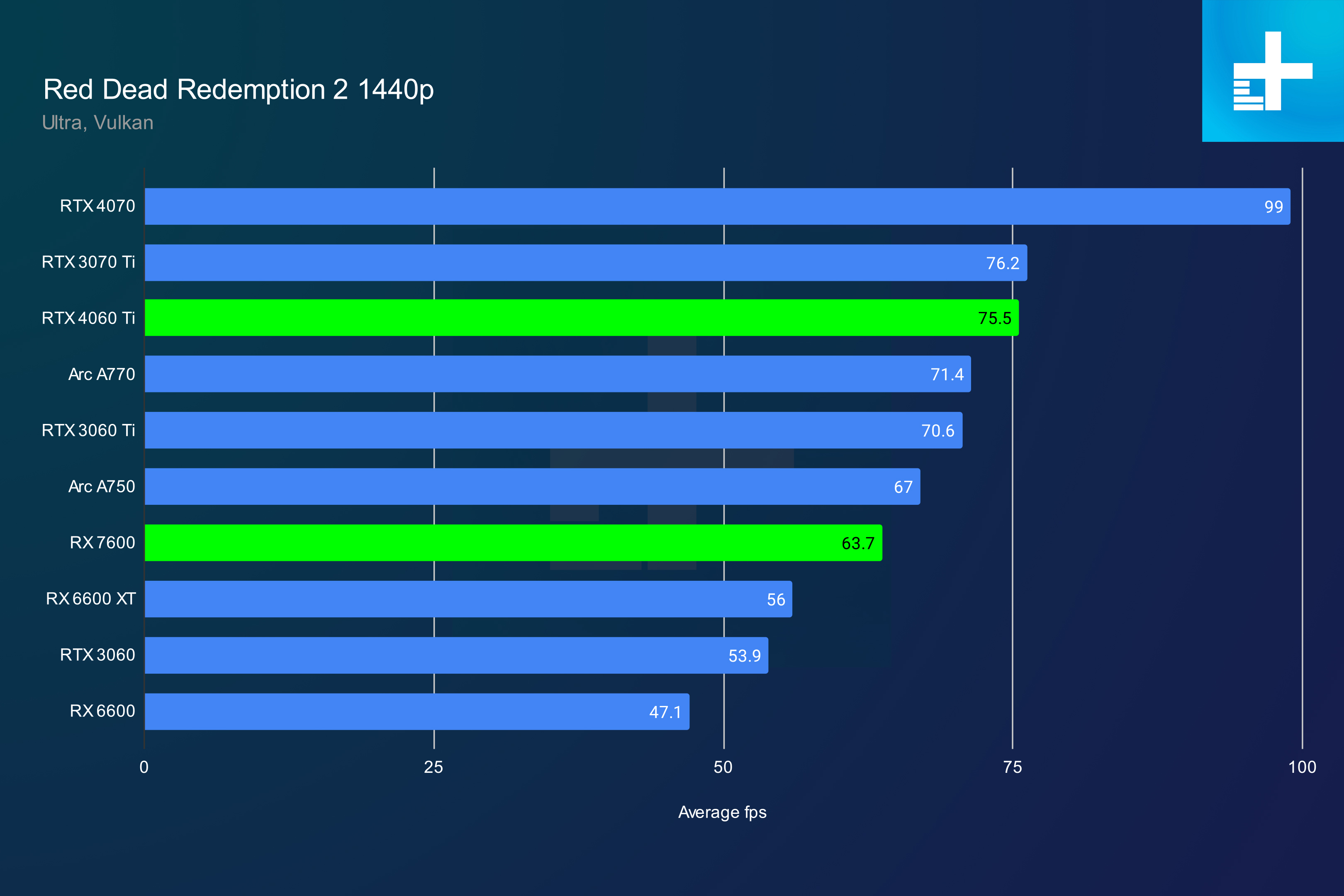
“The AMD RX 7600 isn't flashy, but it delivers a solid value that the GPU market has been sorely lacking.”
- Solid 1080p gaming performance
- Aggressive pricing
- Only a single 8-pin power connector
- Compact design
- Memory interface limits higher resolutions
- Ray tracing performance is lacking
AMD needs to catch up. After making it on the list of the best graphics cards with two flagship models, we haven’t seen any new GPUs from AMD, all while Nvidia has slowly worked its way down the product stack. The AMD RX 7600 is an attempt to capitalize on what gamers are sorely lacking right now — good budget GPUs — without messing with any of the cards in between.
And it succeeds, especially layered on the relatively disappointing RTX 4060 Ti from Nvidia. The RX 7600 is in a different class of GPU, priced at $130 cheaper, and we won’t have a direct answer from Team Green until July. One thing is certain now, though: the RX 7600 offers a compelling upgrade path for 1080p gamers, with solid generational improvements and fantastic value.
AMD RX 7600 specs

It’s weird. AMD went from its flagship RX 7900 XTX and RX 7900 XT all the way down to the RX 7600 without any steps in between. We’ll likely see AMD fill out the range of RDNA 3 offerings throughout the rest of the year, but it’s a bizarre jump when the only cards in AMD’s current generation occupy all the highest and lowest points of the GPU market.
So, naturally, the RX 7600 looks a lot less impressive than the other two AMD GPUs we currently have, but it’s also much cheaper. Clocking in at $270, it’s actually $60 cheaper than last-gen’s RX 6600, which released at the height of the GPU shortage. It’s great to see prices regress to more normal levels now that the shortage is behind us.
| RX 7600 | RX 7900 XTX | RX 7900 XT | |
| Compute units | 32 | 96 | 84 |
| AI accelerators | 64 | 192 | 168 |
| Ray tracing accelerators | 32 | 96 | 84 |
| Memory | 8GB GDDR6 | 24GB GDDR6 | 20GB GDDR6 |
| Memory speed | 18Gbps | 20Gbps | 20Gbps |
| Memory bus size | 128-bit | 384-bit | 320-bit |
| Game clock speed | 2.25GHz | 2.3GHz | 2GHz |
| Connection support | DisplayPort 2.1 | DisplayPort 2.1 | DisplayPort 2.1 |
| Total board power | 165W | 355W | 315W |
| List price | $270 | $1,000 | $900 |
I have some reservations about the $270 price, though. It was a last-minute change, with the card originally reported to debut at $300. Although AMD says multiple models will be available at list price, I wouldn’t be surprised to see some models push above into the $330 to $350 range. Hopefully, there are plentiful options at $270, though. That’s where the RX 7600 provides the best value.
Outside of pricing, the RX 7600 comes with 8GB of GDDR6 memory on a 128-bit bus. That’s the same memory spec as the RX 6600 and the RX 6600 XT. It’s also the same spec as Nvidia’s RTX 4060 Ti, which is under fire right now for its limited memory bandwidth.
And yes, the limited bus and low memory size hurt the RX 7600 at higher resolutions, especially as VRAM demands in games push higher. However, the RX 7600 also comes in $130 cheaper than Nvidia’s RTX 4060 Ti. It’s really not targeting 4K, and that’s the only resolution where we start to see significant memory bottlenecks come into play.
Synthetic performance

Before getting into games, I like to take a look at synthetic performance to get a high-level view of where a card lands. It doesn’t always play out in real games quite like it does in 3DMark, but the suite does a good job of setting expectations on where a card should sit relative to the competition.
That’s true here, with the RX 7600 ending up just below the RTX 3060 Ti and just above the RX 6600 XT. Remember, that latter card launched at $380, while the RX 7600 is offering better performance for more than $100 less. In Time Spy, the card was around 10% faster, which closely aligns with what I saw in games at 1080p and 1440p.

The gen-on-gen improvement is massive — 29% in Time Spy — all while the RX 7600 carries a list price cut of $60 compared to last-gen’s option. Even comparing prices today, which have come down, the RX 7600 is impressive. The RX 6600 is as cheap as $210, while the RX 6600 XT is around $250. Both are cheaper, but the RX 7600 offers performance upgrades worthy of the $20 to $60 increase.
Ray tracing is a bit of a different story. In Port Royal, the RX 7600 still provides solid uplifts over last-gen options, but it’s clobbered by the competition from Nvidia and even Intel’s Arc A750. It’s worth noting, however, that 3DMark is particularly favorable to Intel’s GPUs. Performance closely aligns in real games from Nvidia and AMD cards, but the scores for Intel’s two Arc GPUs are a bit oversized compared to my results below.
1080p gaming performance

AMD is positioning the RX 7600 as a 1080p graphics card, and with a list price of $270, it’s certainly much closer to that than the $400 RTX 4060 Ti. It’s also a lot less powerful than Nvidia’s most budget-friendly RTX 40-series GPU, ending up about 29% slower for 32% less money.
That mainly comes on the back of ray tracing performance, which I’ll dig into later. For now, the gen-on-gen improvements are solid. Over the RX 6600, you’re looking at around a 30% jump. The more important comparison is to the RX 6600 XT, though. The RX 7600 takes a smaller 12% lead over that card, but it’s only about $10 to $20 more expensive at the time of writing. Very easy to justify that price increase given a solid jump in performance.
The comparison to the RTX 3060 is even more favorable. That card goes for around $330 at its lowest, and the RX 7600 is offering around a 17% lead for a cheaper price. That’s factoring in ray tracing, where Nvidia has a lead,. If you look at a game without ray tracing like Horizon Zero Dawn, the RX 7600 is a massive 43% faster, and it even claims a lead over the RTX 3060 Ti. The same is true in Assassin’s Creed Valhalla.
Not all games fare that well, however. In Red Dead Redemption 2, for example, the RX 7600 still beats Nvidia’s last-gen options, but Intel’s Arc A750 and A770 shoot ahead. This is the only game where the RX 7600 takes a clear back seat, though.
AMD is offering a compelling 1080p GPU in the RX 7600. It’s not only $60 cheaper than the price the RX 6600 debuted at, but it still manages to provide a solid value compared to the falling prices of last-gen options, which most GPUs in the current generation have struggled with.
1440p gaming performance

At 1440p, the story for the RX 7600 doesn’t change much. Its lead over the RX 6600 shrinks to 26% on average, and compared to the RX 6600 XT, it’s only 9% better. It’s still the best AMD option in this bracket considering its price, but the real competition is coming from Intel if you factor in ray-tracing titles.
AMD, despite making a strong argument that it improved ray tracing with the RX 7900 XTX, hasn’t put its best foot forward with the RX 7600. Nvidia has a clear lead, but even Intel is far ahead of AMD in the ray tracing department, allowing the $200 Arc A750 to competently compete with the RX 7600.
Without ray tracing, though, the RX 7600 looks similarly impressive at 1440p. It beats the last-gen options in Horizon Zero Dawn once again, though only manages to match the RTX 3060 Ti instead of exceeding it, likely due to the limited memory bus of the RX 7600. The RX 7600 still maintains a lead in Assassin’s Creed Valhalla, though, sitting right next to the RTX 4060 Ti in my benchmark data.
The oddball is, once again, Red Dead Redemption 2. This is the only title in my test suite that uses Vulkan, and AMD’s cards sit at the bottom of the stack, much unlike other games in my suite, suggesting that AMD’s Vulkan driver may not be quite as optimized as Nvidia and Intel’s.
The RX 7600 is still a 1080p graphics card, but it has enough power to drive 1440p at above 60 frames per second (fps) in demanding games like Horizon Zero Dawn and Red Dead Redemption 2. It just misses that mark in Cyberpunk 2077 at maxed-out settings, and it falls short when ray tracing is brought into the mix, but it’s a solid option for 1440p if you don’t mind turning down a few settings or dabbling in AMD’s FidelityFX Super Resolution (FSR).
4K gaming performance

You really shouldn’t be buying the RX 7600 if you want to play games at 4K. It’s not a great experience, so consider these benchmarks more of a scientific look at how the card scales up to higher resolutions. Overall, the scaling compared to last-gen options looks better as games become more constrained by the GPU. The RX 7600 is nearly 40% faster than the RX 6600 at 4K and 16% faster than the RX 6600 XT. That sounds impressive, but realistically, those jumps only represent a few frames.
The bright spot is that the RX 7600 provides a comfortable 30 fps at native 4K in most games, which is something this class of GPU couldn’t say in the previous generation. It doesn’t have enough gusto to crack that mark in a demanding game like Cyberpunk 2077, but again, upscaling and lowered settings can close that gap.
In less-demanding games, the RX 7600 can even crack 60 fps at native 4K, as showcased by Forza Horizon 5. In a game like Horizon Zero Dawn, you could easily push past 60 fps at 4K if you turn down your settings to the Favor Performance preset.
The focus of the RX 7600 is high frame rate, 1080p gaming, or a similar experience at 1440p with a little help from upscaling. If you’re satisfied with lower image quality and 60 fps, though, it can hang at 4K. It’s not an ideal option, but it has enough power to drive console-like experiences at native 4K. That’s something I haven’t seen for the past couple of years, as last-gen options were either too expensive to be competent console replacements or too underpowered to compete (the RX 6500 XT and RTX 3050 weren’t exactly the best GPUs).
Ray tracing
The RX 7600 is a great budget GPU, but that’s despite its ray-tracing performance. At 1080p in Metro Exodus, which is one of the more forgiving ray tracing titles you can play, it looks solid. You’re getting above 60 fps without upscaling, and great scaling compared to last-gen options. The situation changes in more demanding games.
In Bright Memory Infinite, the card barely cracks 30 fps, despite using the Normal ray tracing preset. And in Cyberpunk 2077, it only managed to outpace the RX 6600 and RX 6600 XT by a couple of frames. You would turn on upscaling to play these games with ray tracing on. However, even the Arc A750 and RTX 3060 are offering close to 30 fps without any performance-boosting tricks.
The situation is the same at 1440p, and at 4K, some games are too demanding to benchmark. In Cyberpunk 2077, the RX 7600, RX 6600 XT, and RX 6600 could never crack more than 2 fps.
Ray tracing is possible on the RX 7600, but it wasn’t the generational improvement I was hoping for, especially after seeing ray tracing on the RX 7900 XTX. AMD still has a lot of work to do here, and that’s evidenced by the fact that native 4K is more possible on the RX 7600 than native ray tracing.
There’s also the 8GB of VRAM to contend with. Although it’s hard to surpass 8GB below 4K without ray tracing, many games can push against that limit with ray tracing enabled, even at 1080p. Turning down settings or disabling ray tracing can get around this limitation, but it’s important to note for the RX 7600.
The best option for its price

The RX 7900 XTX and RX 7900 XT were a worrying sign. They undercut Nvidia and offered great performance for the price, but they also showed a trend of AMD riding Nvidia’s coattails to higher GPU prices. The RX 7600 corrects course, marking the first time in this generation that we have a compelling 1080p GPU that offers solid generational improvements and great value.
There are still some issues, particularly with the memory interface if you want to push up to higher resolutions and enable ray tracing. But it’s easily the best option given its price. It’s hard to justify an RX 6600 or RX 6600 XT when both carry the same memory interface and offer lower performance. The competition from Nvidia isn’t even close, with higher pricing even at lower performance classes.
The biggest competition comes from Intel actually, with the Arc A770 vastly outperforming what its price tag would suggest and improving ray tracing compared to the RX 7600. However, it carries a decent price increase over the RX 7600, making AMD’s card a great option if you don’t want to dabble in ray tracing.




























